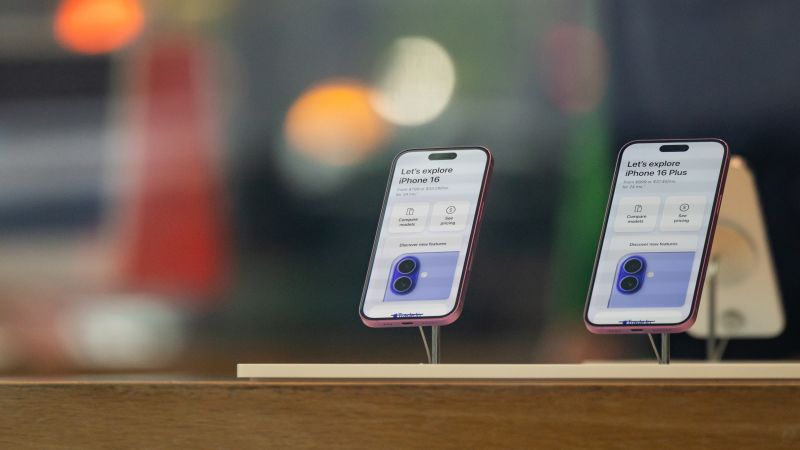In 2011, a pivotal moment occurred when then-President Barack Obama engaged Apple’s co-founder Steve Jobs in a dialogue about the prospects of shifting iPhone production from overseas to the United States. This conversation, as reported by The New York Times, set the stage for a topic that has resurfaced years later under vastly different circumstances. Fast forward to 2025, and the latest instigator is former President Donald Trump, who has ignited this discussion once more with Apple’s current CEO, Tim Cook. The stakes are now notably higher, as Trump has threatened to impose a hefty 25% tariff on Apple and similar smartphone manufacturers if they continue to produce devices outside American borders, especially emphasizing the importance of manufacturing within the United States.
In a recent post on Truth Social, Trump explicitly stated his expectations for Apple: “I have long ago informed Tim Cook of Apple that I expect their iPhone’s that will be sold in the United States of America will be manufactured and built in the United States, not India, or anyplace else.” This direct demand underscores a significant shift in America’s economic stance and its increasing emphasis on domestic production.
Earlier this month, Tim Cook had voiced his anticipation that a majority of iPhones intended for the U.S. market would soon be shipped from India. This aligns with the trend of many tech companies moving their production facilities to countries where labor costs are significantly lower. Trump’s administration previously aimed to revitalize American manufacturing, and since his re-election campaign began, he has renewed his focus on tariffs and policies designed to generate more domestic jobs.
However, experts warn that relocating iPhone production to the U.S. would fundamentally alter Apple’s operational model. Analysts have pointed out that such a move requires more than just relocating assembly lines; it involves complex dynamics of workforce specialization and skill levels that are not easily replicated in the U.S. At present, countries like China and India provide a highly skilled labor force adept in managing the intricate processes of manufacturing millions of iPhones each year. The potential consequences of bringing production stateside could include increased prices for consumers and a reconfiguration of product designs due to the difference in manufacturing capabilities.
Dipanjan Chatterjee, a vice president and principal analyst at Forrester, stated emphatically, “It just fundamentally doesn’t work.” This view is reflective of broader concerns surrounding the nature of American manufacturing today. Apple has yet to respond officially to inquiries about any shifts in manufacturing plans.
China has established a robust assembly structure tailored for electronics production, with Foxconn being a prominent assembly partner for Apple. Foxconn boasts a workforce of around 900,000 employees during peak production seasons, many of whom live in dorm-style accommodations, allowing for swift adaptability in production schedules. The specialized nature of production involves intricate processes that require both deep expertise and a consistent level of craftsmanship.
Moreover, the state of American manufacturing has declined drastically since the 1970s, with only 8% of the American workforce engaged in manufacturing as of early 2025, compared to about 26% in 1970, according to the Bureau of Labor Statistics. Yet, Carolyn Lee, executive director of the Manufacturing Institute, highlights that today’s manufacturing roles demand a modern skill set that encompasses coding and data analytics, revealing a dramatic evolution in job requirements since previous decades.
Amid these challenges, it’s notable that Apple recently pledged to invest $500 billion over the next four years to enhance its U.S. presence, which includes developing research and development efforts, opening a server manufacturing facility, and launching educational initiatives related to smart manufacturing techniques and artificial intelligence. Despite these commitments, the company has clarified that its educational academy will cater to small-to-medium enterprises, rather than directly establishing infrastructure for iPhone manufacturing akin to that in China or India.
Tim Cook himself has recognized the difficulties in this endeavor. He previously emphasized the unique combination of skills available in China that are crucial to Apple’s production quality. Achieving a similar manufacturing prowess in the U.S. would require addressing substantial skill gaps.
The complexities of American manufacturing aren’t just limited to labor; Mohit Kumar, CEO of smart ring company Ultrahuman, described his own experience moving production from India to the U.S. This transition necessitated increased automation to mitigate costs while simultaneously training workers across multiple phases of production.
In conclusion, as the conversation surrounding U.S. manufacturing continues with conflicting expectations and economic realities, both Apple’s leadership and policy makers must navigate these intricate dynamics delicately. Given the shift in the global manufacturing landscape and changing workforce needs, it remains to be seen how Apple might reconcile the demands for domestic production with the practical limitations inherent in such a monumental transition.



